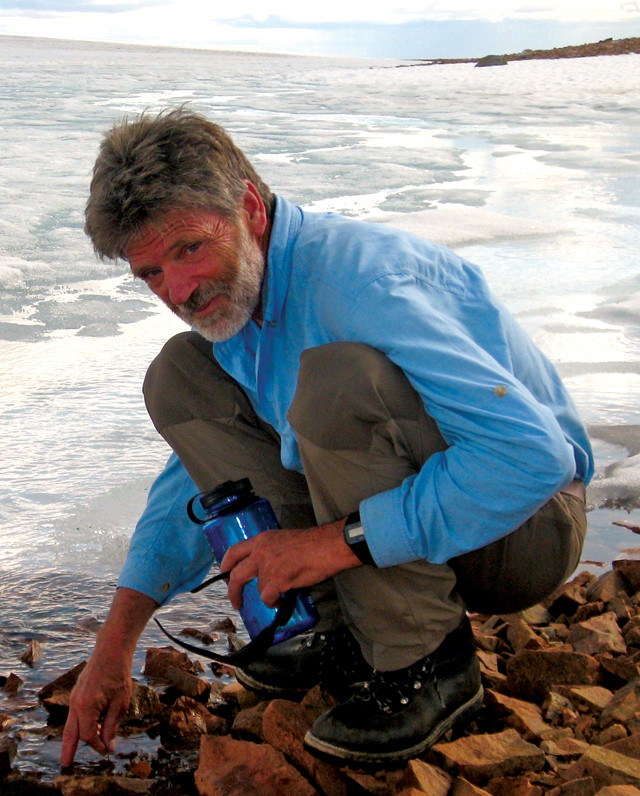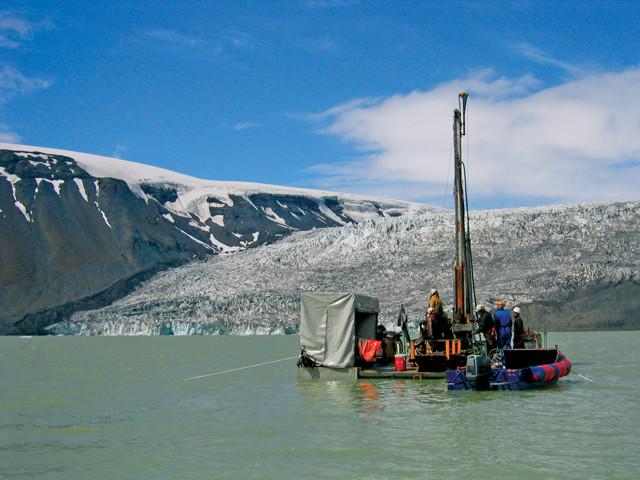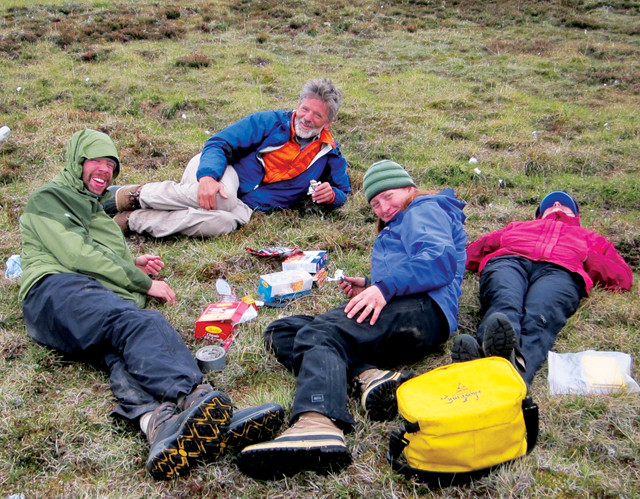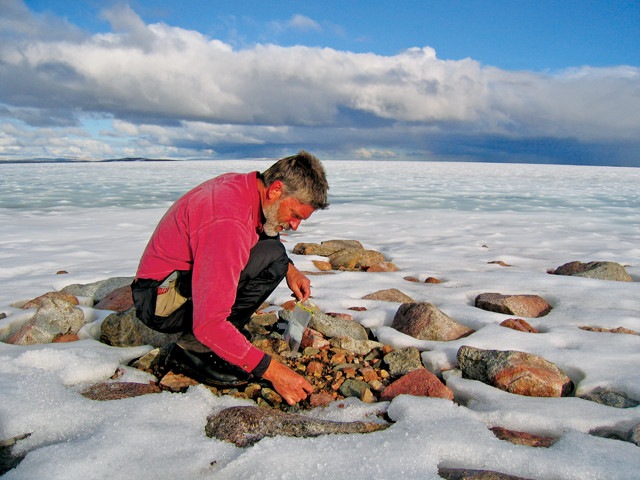
by Kate S. Zalzal Tuesday, June 20, 2017

Gifford H. Miller, a professor of geological sciences at the University of Colorado Boulder and associate director of the Institute for Arctic and Alpine Research, has spent years conducting paleoclimate fieldwork in the Arctic and Australia. Credit: Gifford H. Miller.
“Hope for the unexpected.” This motto has pulled paleoclimatologist Gifford H. Miller to remote corners of the world to conduct fieldwork for more than half a century. Miller, a professor of geological sciences at the University of Colorado Boulder (CU) and associate director of the Institute for Arctic and Alpine Research, thrives on the pursuit of knowledge, asking tough questions about the global climate system whose answers have far-reaching implications. But it’s the thrill of unexpected discoveries — of which he’s made many — that keep him returning for more. His discoveries, including the extinction timing of giant birds in Australia, the existence of “zombie mosses” that document the life-cycle of Arctic ice caps, and the finding of lake sediments that tell the story of Iceland’s deglaciation, have led to advances in our understanding of Earth’s climate history and the role humans have played in it.
Miller didn’t start out interested in geology. After a less-than-successful freshman year in college near his hometown in Michigan, he was drawn to the wildness of Alaska in 1966. There he worked in the VISTA (Volunteers in Service to America) program, which was similar to the Peace Corps but was based in the United States, and tried to make a living as a trapper and dog sledder. He eventually realized that he needed to finish school, so he enrolled at CU planning to major in social sciences. But a geology course, which he added to his schedule at the last minute one semester because he’d heard the field trips were fun, opened up a new world and brought to life a subject that Miller had previously thought was dead. A professor, John Andrews, showed Miller pictures of fieldwork on Baffin Island in the Canadian Arctic, to which Miller responded, “Take me with you.” Andrews agreed and, in 1969, Miller left for the first of many trips he’d take to Baffin. There, he worked on dating neoglacial moraines using lichen, a project that eventually grew into his doctoral thesis, completed at CU in 1975.
After brief stints at the Geophysical Lab at the Carnegie Institution for Science in Washington, D.C., and at the University of Bergen in Norway, Miller returned to Boulder in 1976 to join the faculty at CU, where he’s been studying global change ever since.
Miller recently spoke with EARTH contributing writer Kate S. Zalzal, a former graduate student of Miller’s, on how his research questions have evolved, Arctic versus Australian fieldwork and black swan events in research.
KSZ: What was the state of research into past global change at the start of your career?
GHM: When I first started in geoscience, we were just building chronologies and trying to reconstruct what had happened with the climate. We were just scratching the surface and learning the very basics of Quaternary climate change. I saw a talk given by Francis Bretherton at the National Center for Atmospheric Research in 1981, which is when I heard the term “global change” for the first time. It was the first time I had ever heard someone say: “There’s only one planet here. It’s not just Baffin Island, or Greenland, it’s all connected.” The idea that we should be looking at the planet as one system, coupled between the ocean and the atmosphere, was a complete eye opener for me. I thought it was magic.
KSZ: How did that change in perspective alter your research?
GHM: My fieldwork became more hypothesis-driven. Instead of just collecting data and thinking about it later, we’d say: “If the climate system is doing this, here’s what we might expect to find.” You have to have a good hypothesis and a good strategic plan when doing fieldwork, but you hope that it all goes wrong. If you have a hypothesis, then you already think you know what’s going on. It’s better to have your hypothesis disproven because then you’re really learning something. I always hope for the unexpected.
KSZ: When have you found something unexpected that shifted the nature of your work?
GHM: In the early 1990s, I went to Australia because I was interested in the monsoon there and its huge transfer of energy [from the atmosphere and ocean to land]. I also wanted to go somewhere where the influence of the big ice sheets was at a minimum, and Australia fit that bill. Australia also has an interior drainage system where about one-sixth of the continent drains to a lake that then acts as a giant raingage. My main goal was to date the ancient lake shorelines using radiocarbon and amino acid dates from the eggshells of emu and an extinct bird called Genyornis. From that information, we could tell when the region was wet and when it was dry. We developed a great time series of climate for that part of Australia, but at the same time we also dated the extinction of Genyornis. I never set out to do that, but we had all these dates and we realized that we kept dating emus that were younger but we never saw another Genyornis shell after one tightly defined point. It was the first time anyone had reliably dated the extinction of the big animals in Australia. That paper made the cover of Science in 1999, but the research was completely accidental.
KSZ: When and why did Genyornis go extinct?
GHM: It was about 50,000 years ago. When we were working on this project, there was a lot of debate regarding the timing of humans' arrival to Australia. We knew it was somewhere in the same time frame as the Genyornis extinction, which immediately raised the question of whether there was a human role in the birds' extinction. At the time, we were also trying to calibrate … radiocarbon dates [from the eggshells we’d collected]. When you measure for a carbon-14 date, you also get a carbon-13 value. Usually people ignore the carbon-13 because their primary interest is in the date, but I noticed patterns in the data: Eggshells with ages more than 45,000 years had very different carbon-13 signatures than younger eggshells. I began working with Marilyn Fogel, a biogeochemist at the Geophysical Laboratory, and we realized that the isotopes were recording a major shift in emu diet at the time of Genyornis extinction. Research by others at about the same time confirmed that humans first arrived in Australia about 50,000 years ago. Given that the Genyornis extinction, the change in emu diet that we observed, and human arrival all happened at around the same time, we wondered if there was a connection — perhaps there was a transformation of ecosystems.

Miller and his team recover sediment cores up to 25 meters long from glacial Lake Hvítárvatn, below Langjökull, the second-largest icecap in Iceland, during a joint U.S.-Iceland research effort. Credit: Gifford H. Miller.
KSZ: How could early humans in Australia have changed the ecosystem? Could they have altered the climate?
GHM: It’s an open question right now as to how they could have done that. The most parsimonious answer is that they did it through burning, but finding evidence of this is extremely difficult. The only reason that burning would have changed the climate is if it did something to the land surface that either promoted, or limited, the ability of monsoon moisture to penetrate into the interior of Australia. What does it take to get more or less rain? What does the landscape have to do with it? Those are the questions we’d like to explore now.
This, again, was totally accidental science. Our original research question regarding the Australian monsoon was a good one, but I think a far more interesting result was the unexpected one. I still do fieldwork to investigate specific questions, but I hope I find something that I never expected, because then you’re discovering. There’s nothing more exciting in science than discovery.

Miller and graduate students Kurt Refsnider, Kate Zalzal and Alexis Ault rest after working late into the Arctic summer night drilling sediment cores on Baffin Island. Credit: Chance Anderson.
KSZ: What unexpected findings have come out of your work on Baffin Island?
GHM: Over the past decade, I have been collecting little plants, usually mosses rooted in the soil, from around the edges of small ice caps on Baffin. Radiocarbon dates from the mosses tell us when a plant was last growing and interacting with the atmosphere, or, in other words, when that location was last ice-free. We call them “zombie mosses” because, even if they’ve been buried under ice for hundreds of years, they can still begin to grow again once exposed to sunlight. I was up there in 2010 with a graduate student, camped between two high-elevation ice caps. Our original fieldwork proposal had us looking for mosses around inland ice caps that don’t erode, so they have a high potential to preserve ancient plants. We had argued that fast-moving glaciers along the coast would be too erosive along the ice margin for plants to survive. But, as we sat there waiting for the helicopter, we could see with binoculars places between the fast outlet glaciers on the coast that looked really flat. When the helicopter came in, we asked the pilot to take us there. We found plants that we could date emerging from beneath ice margins between the outlet glaciers. It was a black swan event, a game-changer. It turns out that these sites are all over the island. Our field area went from being a small region on the low-relief central plateau to the entire length of Baffin Island. From this work, we’ve developed an exceptionally accurate way of quantifying past versus present warming. You never want to be so focused on what you said you were going to do that you miss the little doors you should be opening and sticking your head through.

Miller collects rooted plants emerging from beneath a receding ice cap on Baffin Island. Credit: Rebecca Anderson.
KSZ: What continues to draw you to the Arctic?
GHM: I like the unfettered expanse that the Arctic offers and the “in your face” nature of the geology. The lack of trees is a big plus for the work we do. In the past 20 years, Arctic research has taken on a new urgency, both as a canary-in-the-coal-mine warning for the speed of change and, more importantly, because unlike Las Vegas, what happens in the Arctic doesn’t stay in the Arctic. Arctic change has far-reaching consequences for dense population centers. These aspects have greatly increased the number of Arctic scientists and vastly expanded the audience interested in Arctic research.
KSZ: How does the fieldwork differ between the Arctic and Australia?
GHM: In Australia, we eat better food and drink better wine.
KSZ: What role should research scientists take in addressing environmental challenges?
GHM: Scientists are, in general, not qualified to make policy, but they should be able to inform policymakers about important, well-documented scientific understanding, which should be the backbone of good policy. As educators, scientists should focus on helping the next generation to hone their native ability to think critically.
© 2008-2021. All rights reserved. Any copying, redistribution or retransmission of any of the contents of this service without the expressed written permission of the American Geosciences Institute is expressly prohibited. Click here for all copyright requests.